Oyster mushroom – Edibility, Identification, Distribution
Pleurotus ostreatus
Also the Summer Oyster Mushroom – Pleurotus pulmonarius
- Edibility – 3/5 – A good, meaty mushroom, great in stir-frys and to supplement other fungi.
- Identification – 2/5 – 5-20cm diameter pale to dark grey, brown or occasionally olivaceous brackets growing in overlapping tiers; crowded cream to fawn gills running down the full length of the underside, converging to a “nub” but no obvious stipe. Oyster mushrooms can be very variable in appearance according to the substrate on which they are growing. The Summer Oyster Mushroom (Pleurotus pulmonarius), which is equally edible, is considered a distinct species, identifiable by its paler cap, generally smaller size, more obvious stem and appearance in summer/early autumn. Read more about it here.
- Distribution – 3/5 – In no way rare, but I can go for long periods without encountering a good specimen
- Season – Pleurotus ostreatus: November-March – one of the few fungus that can be found during winter, fruiting is stimulated by frost. Pleurotus pulmonarius (summer oyster): May – October
- Habitat – Grows on standing and fallen trees and large branches, especially but by no means exclusively, on beech. It seems to do particularly well on lightening damaged trees.
- Ecological Role – Oyster Mushrooms are sometimes weakly parasitic but more often saprobic. The mycelia of oyster mushrooms captures nitrogen by actively hunting for nematodes (microspcopic worm-like organisms) within its substrate. It lassoes them, paralyses them, then probes into the still-living creature’s mouth before releaseing proteins that digest it from the inside out. Pretty exciting stuff. Mature oyster mushrooms are often home, food and nursery to a range of invertebrates.
- Considerate Harvesting – Leave plenty of brackets for others to admire and forage, and to mature and spread their spores. Cut from the substrate and carry your harvest gills-down in an open weave basket. The fungi might be grateful for this chance to reach new food sources: never discount the possibility that deliciousness could be an evolutionary strategy to use humans as spore-dispersers!
- Lookalikes: The olive oysterling (panelus serotinus) usually has a short, distinct stipe, yellower gills, an olivaceous cap and is usually smaller, flimsier and slimier than true oyster mushrooms. It is considered edible (especially in Japan where it is known as Mukitake and cultivated for its flavour and medicinal properties in the treatment of liver disease) but some research suggests that it may increase the risk of certain cancers – see below for picture and more information. Angel wings (Pleurocybella porrigens) are pale and flimsier, growing only on rotting conifers and come with some very serious considerations – see below.
Oyster mushrooms are becoming quite familiar to most people as they are easy to cultivate and commonly sold in delicatessens and large supermarkets. Rather annoyingly, farmed oyster mushrooms tend to be misleadingly marketed as “wild” mushrooms – read more on this here. There are several subspecies of oyster mushroom, some of which can grow enormous – like the 4kg beauty shown below. Probably the most beautiful mushroom I have ever seen.
They are tasty, meaty mushrooms when in good condition – great for everything from soups to stews, stir-fries to barbecues. They also dry well. Older specimens make excellent mushrumami – a delicious savoury seasoning. See how to make it here.
If you think you have come across some particularly pale, ghostly and flimsy oyster mushrooms growing from mossy conifer stumps and fallen wood in dank coniferous woodland, then you are more likely to have found angel wings (Pleurocybella porrigens). True oyster mushrooms do not grow on conifers, so you are unlikely to confuse them: angel wings are always ghostly white throughout and have a feeling of cold chamois leather. Angel wings used to be considered quite rare, but now seem quite common in older conifer plantations, particularly in Argyll and the West Highlands in the autumn (but seldom in the winter, when true oyster mushrooms tend to fruit). More recently I have found them in Northern England, and heard isolated reports of them in southern English conifer plantations. It is a very beautiful fungi to find in dank misty woodland.
Despite its long history of having been eaten (especially in Japan, though I know some people in the UK who eat them regularly with no ill-effects), there is now clear evidence linking compounds in angel wings with potentially catastrophic brain damage:
“It contains a precursor to an amino acid that does not occur naturally in human bodies. When people with poor kidney function consume this precursor, and it reaches the brain, the amino acid will form, and this can cause severe brain damage, leading to death.”
Or there is a much more accessible digest/discussion of the science and safety here.
There should be some questions about the usefulness of force-feeding rats 100’s of times their own body weight of anything, then drawing parallels with sporadic and limited human consumption. This opens up a whole world of discussion on “edibility”. It isn’t as black and white as people like to think. There are many variables, including dosage, bioaccumulation in the fungi and in the consumer, variations in phenotypes, our own biochemical predisposition (presumably those that eat large amounts of angel wings with impunity are lucky enough to have good kidney function), as well as the age and condition of the plant or mushroom in question. You can read more about this in this blog:
The Day I Ate A Deadly Plant: The Spectrum of Edibility
A less worrying misidentification often occurs with the olive oysterling (panelus serotinus), which is widely used as food and medicine in Japan, but can have a tendency to taste bitter when growing on certain substrates, and has been linked with an increased risk of some cancers. Research on this appears to be in German by mycologist Andreas Gminder. If anyone has access to an English version of the research, I’d love to see it and share it here.
Related Pages:
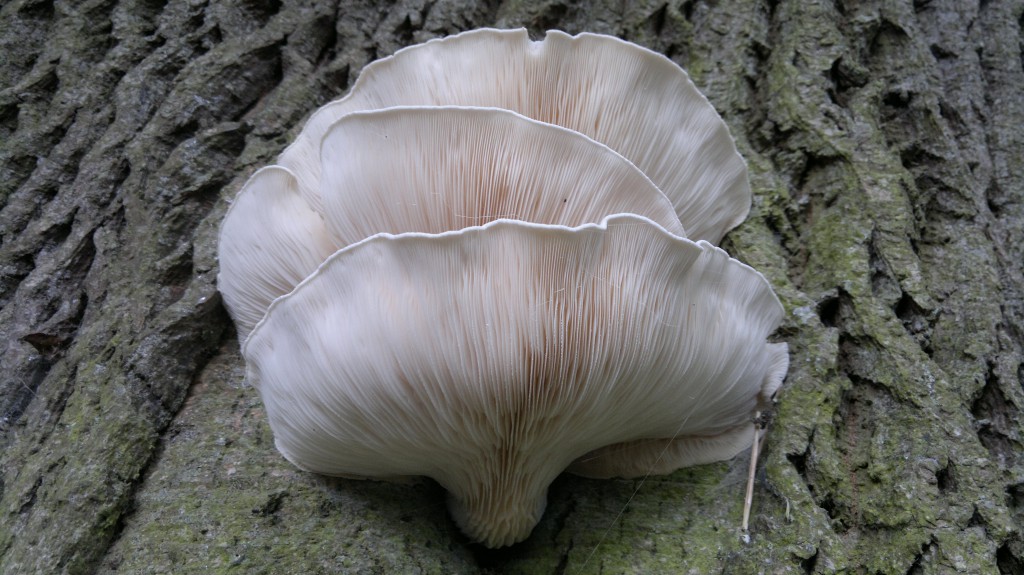
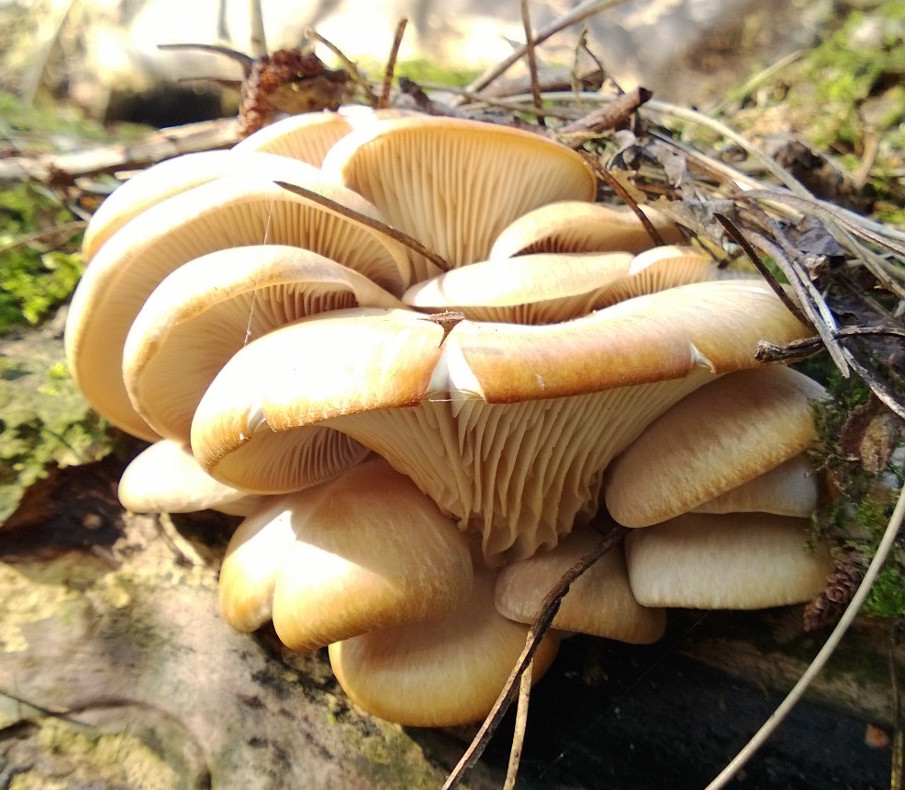
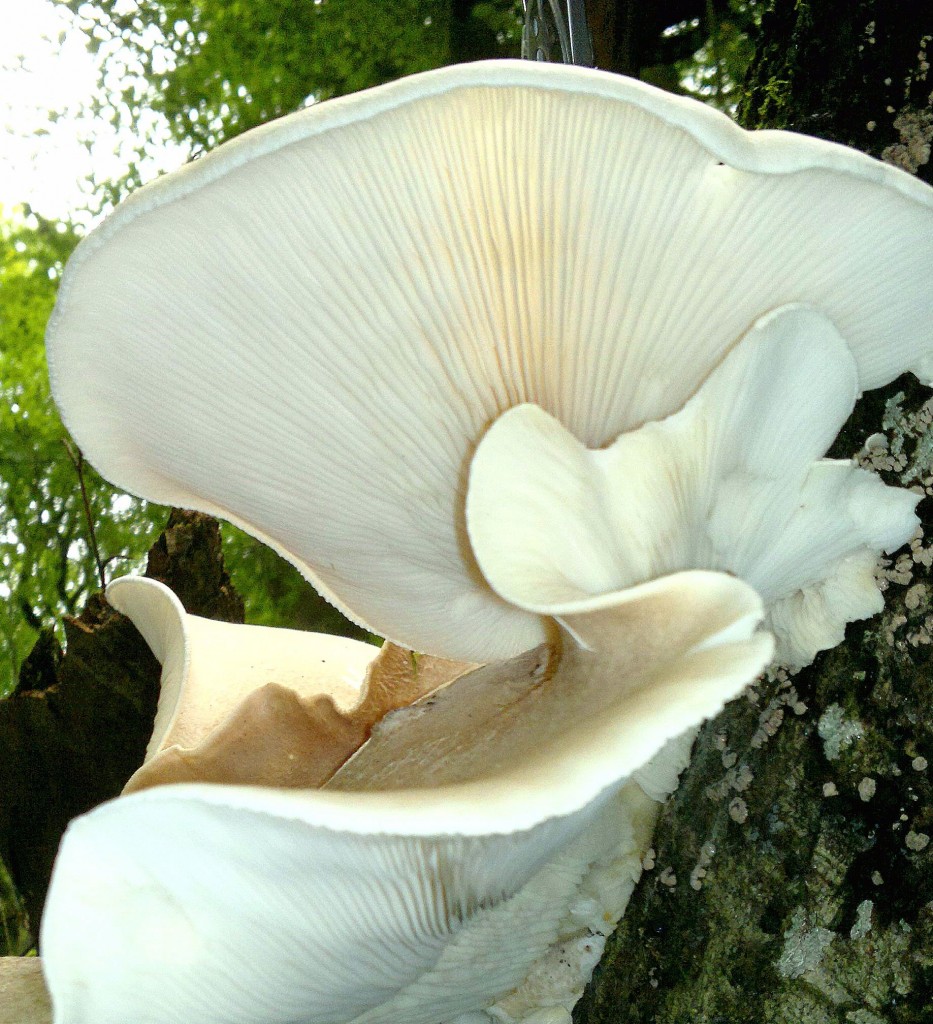
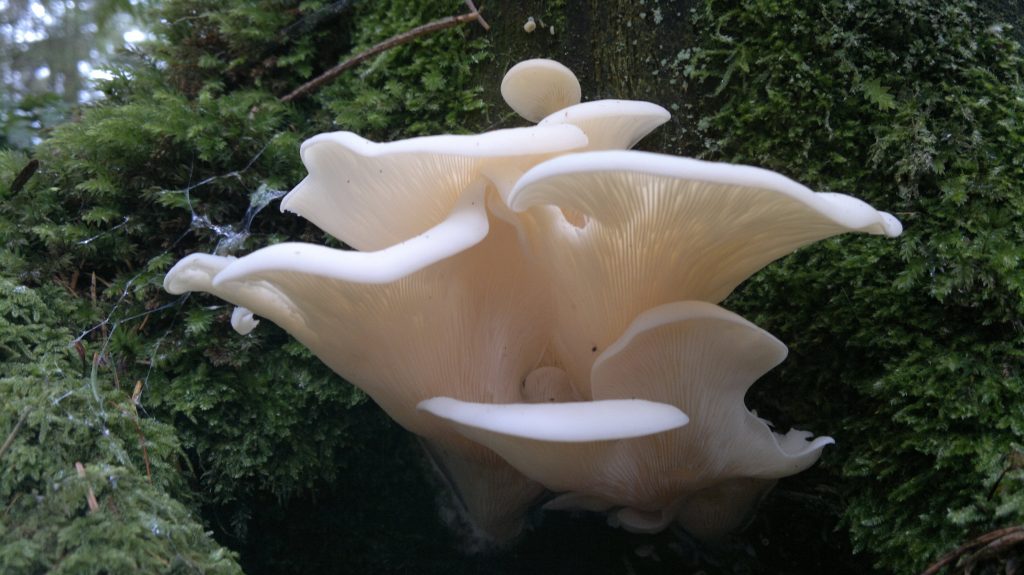
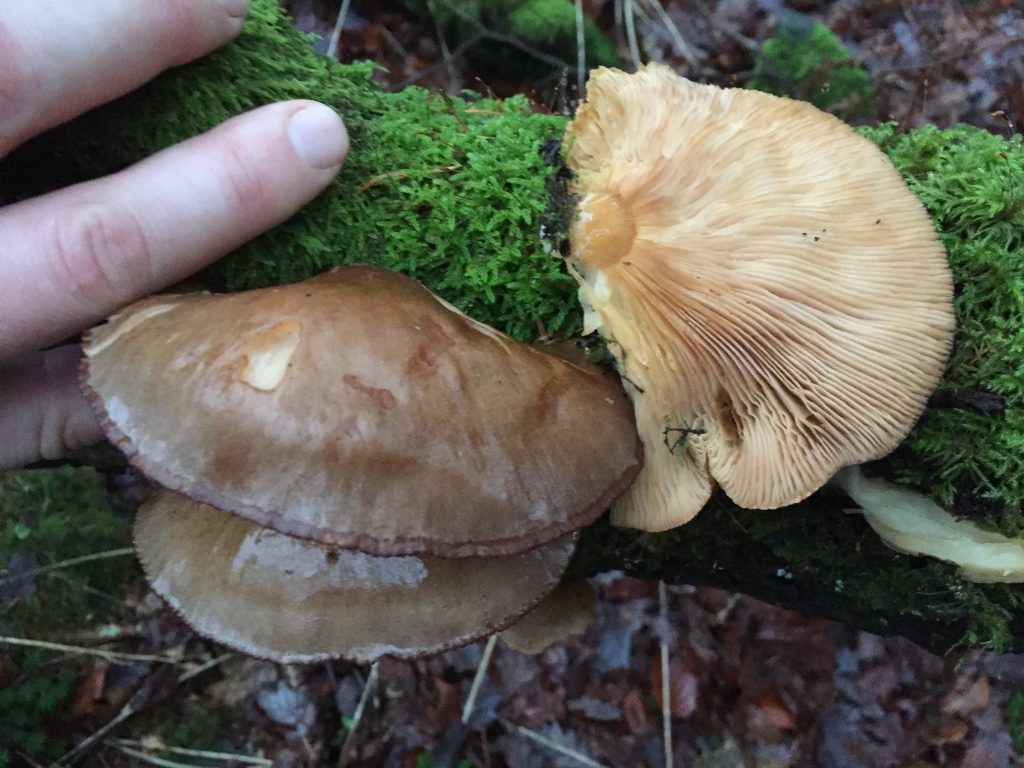
40 Comments
do you know of anybody who farms oyster mushrooms in Scotland?
Hi Bryan,
Sorry, no I don’t. Most of the exotic cultivated mushrooms are grown down South or in Ireland as far as I know.
Mark.
Soz Half a message,my friend say’s hes getting oysters in late April but there little delicate things, pure white , that he says melt in your mouth! Doesnt sound like them.
I ate some orange things he found on a log and he said he was eating them for year’s and didnt feel to well. I dont think he know’s what he’s doing!
Hmm..oyster mushrooms can appear at almost any time of year, but tend to be fairly robust. Possibly angel wings? Eating small orange mushrooms off logs without a firm ID is asking for trouble. Chances are if he’s picking them in winter they are velvet shank. But there are many other things they could be – including funeral bells! Positive ID required! All these fungi appear on this site somewhere – use the search box to learn more. Stay safe!
Is there a solid reason why you say to avoid olive oysterlings?
I have seen them listed as edible in some references and inedible in others.
I have also read accounts of folks who eat them with glee!
I ask because we have a good few around my patch of D&G at this time and I am itching to sample them.
Hi Andy,
I’ve never eaten them myself. I think I was basing this on the fact that they aren’t generally listed as edible (at least in my books). I do eat plenty of stuff that the guide books have got wrong, so will have a go! I certainly don’t know of any reports of toxicity and would be interested to read any links you might have to people who enjoy them. I see them reasonably often through the winter, though never in any great quantity. Please let me know how you get on with them.
Best wishes,
Mark.
I found some mushrooms growing on some dead wood but I’m not sure how to identify them. They look like oyster mushrooms but have a sponge like membrane on the bottom and tan colored top. Can you identify please? If I knew how to send a picture I would. Sorry!
Hi Bob. Sounds like they could be dryad’s saddle, which is just coming into season. Not super-edible…see here
My husband and I love dryad saddle, when young if you cut the underside off, and marinade them in teriyaki sauce they are amazing in stir fry. The have a cucumber smell but the texture is great and soak up flavor like a sponge. Since most people avoid them because they don’t have a typical mushroom taste that means more for us
I eat Dryad’s Saddle. You have to get them young.
Yes I agree – I posted on dryad’s saddle here:
Hi Mark, every year i find very big mushrooms on a dead fig trunk, in June. They look like pleurotus pulmonary to me, they smell nice and are very fleshy and havy. But my fear is that they might be angel’s wings. Will you tell me how can I be sure ? I keep them in my frig , waiting for your answer.
thank you
Ariela (from Israel)
Hi Ariela,
Sorry, slow reply, i’ve had some trouble accessing my website – guess you’ll have thrown it out by now!
Its impossible for me to say without seeing a good picture.
Dryad’s saddle is common in the UK in June (don’t know about Israel!)- check it out here: http://www.gallowaywildfoods.com/?page_id=1126
Cheers
Mark.
Found what I believe to be yellow oyster mushrooms growing on and upright dead tree. They meet all the ID I’ve been reading but still slightly concerned being they are yellow
Hi Andrew,
If it is clearly yellow (as opposed to creamy/off white), and definitely an oyster mushroom, it could be that you have found an escaped cultivar. Yellow versions of oyster mushrooms are now widely cultivated. And then marketed as “wild”! Grrrr….
Cheers
Mark
Hi Mark
Re: Angel’s Wings.
I’d be very reluctant indeed to advise people that eating this species is safe. Cross-contamination by gastro-intestinal irritants?
There is now scientific proof of the mechanism by which this species causes brain damage. It contains a precursor to an amino acid that does not occur naturally in human bodies. When people with poor kidney function consume this precursor, and it reaches the brain, the amino acid will form, and this can cause severe brain damage, leading to death.
http://www.researchgate.net/publication/49786606_Proof_of_the_Existence_of_an_Unstable_Amino_Acid_Pleurocybellaziridine_in_Pleurocybella_porrigens
Hi Dan, thanks for this information. I will amend my information accordingly.
Edibility is a moveable feast in many ways, not least due to ongoing scientific research. I am a little sceptical about the usefulness of experiments involving the force-feeding of things to rats. If we were to force-feed any animal 100’s of times its own body weight of a substance over a short period, i’d expect to see some serious repercussions that may not necessarily provide meaningful insight. This has happened with regard to comfrey too, resulting in some fairly unhelpful scaremongering and blindly regurgitated “facts”.
While I very seldom eat angel wings (due to the fact I don’t rate them highly and there tends to be much nicer fungi about without any suspicious toxicity reports), I know some who like and eat them fairly regularly, including a chef who has served them on his menu (contrary to my advice). Perhaps we’ve all been playing russian roulette!
Nevertheless, I do take this research seriously, and will be teaching about them not as a “species with some suspicions around edibility”, but as a potentially deadly fungi, with a history of having been eaten, from now on. The brown roll-rim also falls into this category. I like these grey areas. They are useful for opening up discussions on what we think of as “edible”. I wrote more widely on this here: http://www.gallowaywildfoods.com/?page_id=1675
Cheers,
Mark.
hi just found a large what i think are oyster mushrooms growing on a old cut down tree greyish silver in colour all over lapping each other as oysters do?
Could be, though it not possible to say from a brief description like that. It can be hard enough with photos!
Could use some help identifying what I THINK is an oyster… found in my wood pile
pictures: http://s32.photobucket.com/user/onyx_deathstalker/library/Mushrooms
Hi Amber,
Sorry, I think I missed this comment. Probably a bit late now, but yes, this looks like an oyster mushroom!
Cheers
Mark
Hello im curious on any sure fire ways to differentiate angel wings and oysters, from what ive read is that angel wings grow primarily on confires, and are really delicate, while oysters like hardwoods. I found some i suspect to be oysters today growing on a dead pacific oak here in Northern California. Any help us greatly appreciated.
Hi Nico, I can’t really add much to the information already on this page. Coniferous host, ghostly white throughout, and a feeling of damp chamois leather are key. Its easy to imagine confusing them, but angel wings are really quite distinctive when you meat them in the flesh, so I wouldn’t be overly worried.
Mark.
Hi, I’ve eaten tonnes of angel wings for years with no ill effects but will stop now. Thanks for sharing!
Hi Mark
Just found your site looking for I/d of an Oyster look-a-like. Large troops growing on a dead Beech tree, rather soggy( never stops raining in Dumfriesshire) whiteish/grey caps some concave/convex, white gills but adnexed not decurrent, short stem, offset. Any suggestions please
None beyond what is on this page. There are several phenotypes of oyster mushroom – quite variable according to host. Also, not really like oysters at all, but slimy beech tuft is v common on beech.
HI mark: I found what looks like oyster mushrooms growing on the stump of a long dead spruce just today – April 25 in Washington State – USA. Since they are growing on a dead spruce and you said they dont grow on conifers – should I assume that this is something else like one of those saddle mushrooms?
Hi Ronni, Maybe, but I can’t really say what delights (and dangers) you might have in Washington State.
I have a picture & I’d like someone to identify the mushroom for me please.
I’m happy to have a look if you post it to my FB or Twitter pages (or email)- but please read my guidance first on how to make a useful ID request here:
Cheers, Mark
Hi my name is Tawana I have a question I was wondering if anybody can answer it I found some oyster mushrooms they were halfway dried I put them in a bowl of water and they look like they’re fresh I was wondering if they’re edible or how do you know when it’s they’re too old to eat
Sounds like you have rehydrated some naturally dried mushrooms. Cook thoroughly, then try a small bit, if you feel its for you.
IDown here in north somerset I’ve been finding loads of oysters and it’s the beginning of January feeling blessed!
Lovely! They do love a cold snap! 🙂
Can Oyster mushrooms grow on the ground?
No, not unless there is buried wood.
I’ve found a patch of these growing on a living, healthy tree. I can’t find any information confirming either way if this is bad, as all the information says they grow on dead wood.
Thoughts, Mark?
Hi Luke, While they are most often found on dead/dying/fallen wood, its not that unusual to find them on trees that look (at least outwardly) quite healthy. Mark.
I found some nice oysrers today but after sauteing they are tough as an old shoe ! What can i tenderize them with ?
I’ve never had this problem with oyster mushroom before. Are you certain you have the right mushroom!?